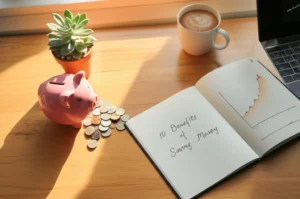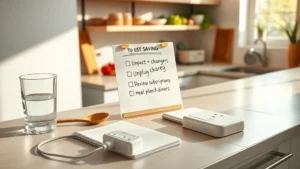Missing the Obvious?
Ever stop and wonder… where does all my money actually go each month? It’s wild, right? You get paid, you swear you’ll be careful, but by the 25th you’re digging through couch cushions for that last Starbucks run. Been there. In fact, if I had a dollar for every time I promised myself “this month will be different,” well, I’d have a decent little side stash right now. Let’s just admit it—bad financial habits are sneaky thieves. So today, let’s call them out, share some laughs (and cringes), and maybe—just maybe—walk away a little richer in the end.
This isn’t another dry lecture. We’re talking real-life, spill-your-coffee relatable stuff… the daily money drips that add up before you even know it. Grab your mug and pull up a chair—let’s talk about bad financial habits examples, and how you (and honestly, me too) can start kicking them for good.
It Starts So Small
How Does This Keep Happening?
You know that feeling when you check your bank app and… oof, that balance? Most of us don’t blow the bank on big-ticket items—it’s more like, little things pile up. You pick up a snack, you subscribe to a streaming service you barely watch, you cave for that BOGO deal online because hey, why pay full price later, right?
But those “just this once” buys snowball shockingly fast. According to research on spending habits, something as basic as grabbing coffee or dining out, even a few times a week, can slice hundreds from your savings a year. True story: my friend Brit tracked her “tiny treats” for a month and nearly fainted at the $140 tally—on lattes, muffins, random “treat yourself” app buys. She could’ve funded half a weekend getaway. Sound familiar?
Daily Habits, Yearly Cost
| Habit | Monthly Cost | Yearly Hit |
|---|---|---|
| Daily Latte | $38 | $456 |
| Weekly Takeout | $40 | $480 |
| Forgotten Subscriptions | $10 | $120 |
Combine a few little leaks, and suddenly you’re looking at what could’ve been a vacation… or your emergency fund. (Ouch. I know.)
The Budget Gets Ignored
Why Is Budgeting So Dull?
I get it. The word “budget” = instant snooze for a lot of us. But here’s the thing nobody tells you: not budgeting is, ironically, more stressful than actually tracking your money.
Not having a plan is the classic recipe for “where did my money go?” syndrome. It’s too easy to tap and swipe and kid yourself that things are under control. But avoiding the budget means you’re basically walking blindfolded through a minefield of late fees, debt, and missed savings. Yikes.
Confession: I once went an entire semester in college without a budget, convinced I kinda, sorta “knew” my spending. Result? Two overdrafts, a phone call home for help (mortifying!)… and a crash course in Financial habits of students when you screw up. (Spoiler: Set up a budget before emergencies, not after.)
Quick Fix: Get Real, Set Limits
- Download any free budget app—yes, ANY. Doesn’t have to be fancy.
- Actually look at last month’s spending. No judgment, just data.
- Pick one thing to cut (for me? I ditched my forgotten digital magazine).
- Pretend it’s a game… How much can you “save” without feeling deprived?
Boring? Maybe a tiny bit. Satisfying? Weirdly, yes. Extra points: link your small savings to a treat or a goal. That’s what finally helped me stick with it.
Sales Trap: The “Spaving” Curse
Ever Buy Stuff… Just Because It’s On Sale?
This habit punches me in the gut every time. “It’s not spending, it’s saving!” we tell ourselves, while bagging another sweater because… what if it’s gone forever?! This is called spaving—spending money to ‘save’ money. If you’ve added random gadgets just to snag free shipping, welcome to the club. I’ve done it so many times I’ve lost count.
Here’s the crazy part: experts say this “sale brain” triggers our reward system, but the happy buzz rarely lasts. More often, we end up with clutter and less cash for stuff we actually need (this research on “spaving” is painfully accurate). A friend of mine finally unsubscribed from all promo emails. She was shocked—her spending dropped almost $60 that month. All from not having those ‘limited-time’ temptations flashing at her every day.
How to Dodge the Deal FOMO
- Unsubscribe from promo emails—really, try it for a week.
- Make a “wait list.” If you still want it in 72 hours, reconsider.
- Remind yourself: the best ‘sale’ is not buying what you didn’t really need.
When Sales Are NOT Savings (A Quick Comparison)
| Scenario | Score a Deal | Skip the Sale |
|---|---|---|
| Add $20 to reach free shipping | Spend $40, get $5 off, but don’t use the extra stuff | Spend $25, pay $5 shipping, actually save $10 |
| Buy 2-for-1 offer | Buy two, one sits unused | Buy none, save 100% |
For more on building better spending patterns, check out Good financial habits for young adults.
Late Fees & Forgotten Bills
Why Do Late Fees Hate Us?
You know the drill… you meant to pay that bill, but then there was a work thing, or the app glitched, or you truly just forgot. One missed due date turns a $50 bill into $78, and your mood goes from “meh” to “why am I like this?” in 10 seconds flat.
Not paying bills on time isn’t just about feeling a bit sheepish. Those fees are basically money torched for nothing. And if you let it slide, it can even ding your credit score (that’s that pesky number that says whether you can one day buy a car, a house, or even get that fancy phone plan).
This is a classic in the 5 bad money habits hall of fame. Seriously, I once lost $185 in late fees during a year I was “too busy” to check my auto-pays. Fixing it was way less stressful than I thought—it came down to one lunch break, a handful of calendar alerts, and a promise to myself: “If it’s due, do it.” Maybe over-simple… but hey, it worked.
Easy Wins: Stay Ahead of Late Fees
- Set up auto-pay wherever possible.
- Add reminders to your phone (last-minute works better than early for some reason…)
- Bundle bills together—pay them all every payday.
If you want student-focused solutions for dodging fee traps, read Healthy financial habits examples for students.
“Retail Therapy” (Or: The Emotional Shopping Spiral)
Does Shopping “Fix” Bad Days?
Okay, this is a big one—especially for anyone who gets overwhelmed and just… wants to feel better, even for five minutes. Me? After a breakup, I filled an online cart with random home stuff. Did anything fit my style? Nope. Did I feel better? Only until the box landed with a thud (and so did the buyer’s remorse).
This emotional impulse is real. Buying things can light up our brains for a second—like sugar, but for your bank account. The catch? What started as a mood boost can quickly turn into a habit, draining hundreds every time stress or sadness hits. Stories about family habits show a lot of us pick this up young. And it’s a double whammy if you’re learning about money from parents who also use spending as a fix-it tool.
Feel-Good Money Habits Instead
- Replace “add to cart” with “go for a walk,” “call a friend,” or “bake cookies” instead. (Sounds basic, but it really works.)
- Share your money goal with a friend who can check in when you want to splurge.
- Write down your emotion before buying anything non-essential; wait a week and re-read. (Most of the time, you’ll roll your eyes at your own list.)
Looking for inspiration? The post 10 good money habits reveals some low-pressure ideas to help you reset after emotional days.
No Emergency Fund Means Trouble
Do You Have a Safety Net?
You knew we’d get here eventually— the emergency fund is that nagging, grown-up money bucket everyone says you need (but honestly, how many of us have more than $200 if stuff really hit the fan?).
When you don’t have one? Even small surprises—a dead phone, a minor car fix—force you to take on new debt, or borrow from family, or worse… let unpaid bills multiply. It’s not just a student thing; grown-ups are scrambling too (see what Experian says about emergency funds).
My own wake-up call was a dentist bill last year. No savings, so I used my “emergency” credit card… which, let’s be real, is just code for “pay double with interest.” After that? I auto-transferred $10 a week till I hit $400—enough to breathe a little easier. Tiny snowballs really do build a snowman, I promise.
Step-by-Step: Starter Buffer Plan
| Step | Action | Goal |
|---|---|---|
| 1 | Auto-transfer $10–$20/week | $500 stash |
| 2 | Sell one unused item/month | Double your buffer! |
| 3 | Cut out one small habit (like meal delivery once/week) | Bump up savings +$300/year |
So… Now What?
Phew, that was a whirlwind—if you’re still reading, you’re serious about making changes (and maybe recognized yourself once or twice; don’t worry, you’re not alone!).
From small daily spenders to serial “spavers” to the just-can’t-budget crowd, these bad financial habits examples sneak up on all of us. The good news? Even the messiest habits can be broken, and it doesn’t have to mean giving up everything fun. Start by picking just one habit you’d like to tackle this month—seriously, just one—and see what happens. Maybe you’ll catch an extra $40 before it slips away. Maybe you’ll finally have cash stashed for emergencies. Maybe you’ll just stress less (which is worth its weight in gold, honestly).
If you want more ideas or proof that even busy, “messy” people can turn it around, look at 5 bad money habits or revisit Good financial habits for young adults and 10 good money habits for a little nudge in the right direction.
One last thing: it’s not about being perfect. It’s about catching the small leaks and plugging them for good. Today, tonight, tomorrow morning—whenever you feel that first spark to do better—just start. You’ll thank yourself when coffee day rolls around and you don’t have to worry what’s left in your account… because you already know. So, what’s your first move? Drop me a note or share your ‘aha’ moments—I’ll be here cheering you on.













